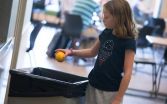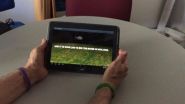(Press-News.org) Less than a month before Congress votes on whether to reauthorize a controversial program mandating healthier school lunches, a new study confirms the suspicions of school officials - many students are putting the fruits and vegetables they're now required to take straight into the trash, consuming fewer than they did before the law took effect.
The new study, published online in Public Health Reports on Aug. 25, is the first to use digital imaging to capture students' lunch trays before and after they exited the lunch line.
It is also one of the first to compare fruit and vegetable consumption before and after the controversial legislation - the Healthy, Hunger-Free Kids Act of 2010 - was passed.
After passage of the legislation and the USDA mandates it put in place 2012, the study found that students put more fruits and vegetables on their trays, as required, but consumed fewer of them and increased waste by approximately 35 percent.
"The basic question we wanted to explore was: does requiring a child to select a fruit or vegetable actually correspond with consumption," says Sarah Amin, Ph.D., a researcher in Nutrition and Food Sciences at the University of Vermont and lead author on the study.
"The answer was clearly no," she said. "It was heartbreaking to see so many students toss fruits like apples into the trash right after exiting the lunch line."
Digital imaging produces fast, accurate data
Amin and her co-authors documented almost 500 tray observations over 10 visits to two elementary schools in the Northeast before implementation of the USDA guideline and almost twice as many observations afterwards.
Forty to 60 percent percent of the students at the schools qualified for free or reduced lunch, a marker for low socioeconomic status.
The research team used a digital imaging method that they validated three years ago in the Journal of the Academy of Nutrition and Dietetics to measure consumption.
The new methodology, which involved visual estimations and calculations based on digital photographs of trays as students reached the cashier and again after they passed the food disposal area, was faster and more accurate than conventional methodologies that simply weighed food waste.
"The beauty of this method is that you have the data to store and code to indicate what was selected, what was consumed, and what was wasted as opposed to weighed plate waste, where everything needs to be done on site," said Amin, who hopes to develop an online training tutorial that could be used by schools across the country to measure consumption and waste.
Revisiting past practices part of answer to increasing consumption
In an earlier study published in the Journal of Child Nutrition and Management, Amin and colleagues looked at what types of fruits and vegetables children selected prior to the new guideline.
They found that children preferred processed fruits and vegetables such as the tomato paste on pizza or 100 percent fruit juice rather than whole varieties.
In addition to making sure those options are available, Amin and her colleagues offer these additional strategies in the paper for increasing fruit and vegetable consumption in school lunch programs:
Cutting up vegetables and serving them with dip or mixing them in with other parts of the meal;
Slicing fruits like oranges or apples, rather than serving them whole;
Adopting promising strategies targeting school settings such as Farm-to-School programs and school gardens, which can encourage fruit and vegetable consumption in addition to what the cafeteria is providing
Putting public health programs in place that encourage fruit and vegetable consumption in the home, which could carry over to school.
Once schools have fully acclimated to the guidelines, Amin thinks consumption will increase, especially for students who entered as kindergarteners under the new guidelines in 2012 and know no other way.
"An important message is that guidelines need to be supplemented with other strategies to enrich fruit and vegetable consumption. We can't give up hope yet."
INFORMATION:
Amin's co-authors at the University of Vermont include research associate Bethany Yon and Rachel Johnson, the Robert L. Bickford Jr. Green and Gold Professor of Nutrition and Food Sciences, and Jennifer Taylor, a graduate student at UC-Davis.
People of all ages recently lined up to do some fishing at the Museum of Science in Boston. And oddly, the fish they hoped to hook were not good ones.
Museum goers were invited to play "Fish Police!!" is a video game that challenged players to rid a river of its bad fish, while sparing its good ones. The catch? All the fish looked exactly alike, and could be told apart only by the way a fish puffed in size: a bad fish puffed just a little faster. After all, it was nervous that it would be caught.
The game's premise may sound a little fishy, but it has helped a team ...
Amsterdam, NL, August 25, 2015 - Patients with relapsing-remitting multiple sclerosis (RR-MS), the most common form of the disease, often have deficits in two neuropsychological functions, autobiographical memory (AM) and episodic future thinking (EFT), which impact quality of life. In a new study published in Restorative Neurology and Neuroscience, researchers report that training RR-MS patients in mental visual imagery (MVI) can improve AM/EFT functioning.
AM facilitates the ability to remember personal detailed events within a specific location and timeframe. EFT enables ...
Murderers who kill intimate partners and family members have a similar profile
One-third of all women murdered in U.S. are killed by male partners
Wives and family members wrongly think 'my husband or son would never hurt me'
CHICAGO --- Murderers who kill intimate partners and family members have a significantly different psychological and forensic profile from murderers who kill people they don't know, reports a new Northwestern Medicine study that examined the demographics, psychiatric history and neuropsychology of these individuals.
The new knowledge about ...
HOUSTON, August 25, 2015 - Pancreatic cancer is extremely deadly and often has a poor prognosis. Ranked as the fourth deadliest cancer in the U.S. and poised to move up within the next few years, pancreatic cancer is very difficult to detect in its early stages. Seldom diagnosed early and typically spreading rapidly, the disease has no effective treatment once it advances.
University of Houston researchers are on a mission to develop drugs that will allow physicians to prolong patient survival and, possibly, even eradicate this deadliest of cancers.
"Our research ...
Two studies in the August 25 issue of JAMA examine the effect of physical activity and nutrient supplementation on cognitive function.
In one study, Kaycee M. Sink, M.D., M.A.S., of the Wake Forest School of Medicine, Winston-Salem, N.C., and colleagues evaluated whether a 24-month physical activity program would result in better cognitive function, lower risk of mild cognitive impairment (MCI) or dementia, or both, compared with a health education program.
Epidemiological evidence suggests that physical activity is associated with lower rates of cognitive decline. ...
Among U.S. veterans who returned from Afghanistan and Iraq, being separated from the military for misconduct was associated with an increased risk of homelessness, according to a study in the August 25 issue of JAMA.
Adi V. Gundlapalli, M.D., Ph.D., M.S., of the VA Salt Lake City Health Care System, Salt Lake City, and colleagues analyzed Veterans Health Administration (VHA) data from U.S. active-duty military service members who were separated (end date of last deployment) from the military between October 2001 and December 2011, deployed in Afghanistan or Iraq, and ...
Among children with in-hospital cardiac arrest with an initial nonshockable heart rhythm who received epinephrine (adrenaline), delay in administration of epinephrine was associated with a decreased chance of 24-hour survival and survival to hospital discharge, according to a study in the August 25 issue of JAMA.
Approximately 16,000 children in the United States have a cardiac arrest each year, predominantly in a hospital setting. Epinephrine is recommended by both the American Heart Association and the European Resuscitation Council in pediatric cardiac arrest. Delay ...
In preliminary research, the detection of persistent leukemia-associated genetic mutations in at least 5 percent of bone marrow cells in day 30 remission samples among adult patients with acute myeloid leukemia was associated with an increased risk of relapse and reduced overall survival, according to a study in the August 25 issue of JAMA.
Approximately 20 percent of adult patients with acute myeloid leukemia (AML) fail to achieve remission with initial induction chemotherapy, and approximately 50 percent ultimately experience relapse after achieving complete remission. ...
For patients with an often-deadly form of leukemia, new research suggests that lingering cancer-related mutations - detected after initial treatment with chemotherapy - are associated with an increased risk of relapse and poor survival.
Using genetic profiling to study bone marrow samples from patients with acute myeloid leukemia (AML), researchers found that those whose cells still carried mutations 30 days after the initiation of chemotherapy were about three times more likely to relapse and die than patients whose bone marrow was cleared of these mutations.
The study, ...
Several Palaeozoic mass extinction events during the Ordovician and Silurian periods (ca. 485 to 420 to million years ago) shaped the evolution of life on our planet. Although some of these short-lived, periodic events were responsible for eradication of up to 85% of marine species, the exact kill-mechanism responsible for these crises remains poorly understood.
An international team led by Thijs Vandenbroucke (researcher at the French CNRS and invited professor at UGent) and Poul Emsbo (US Geological Survey) initiated a study to investigate a little known association ...



